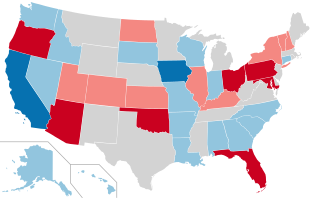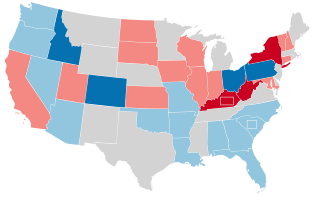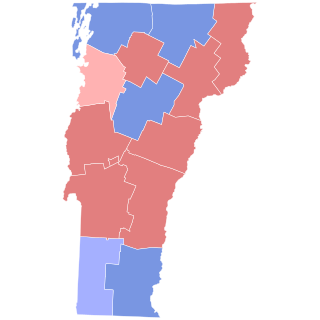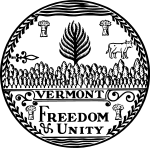
George David Aiken was an American politician and horticulturist. A member of the Republican Party, he was the 64th governor of Vermont (1937–1941) before serving in the United States Senate for 34 years, from 1941 to 1975. At the time of his retirement, he was the most senior member of the Senate, a feat which would be repeated by his immediate successor Patrick Leahy.

The 1968 United States Senate elections were elections for the United States Senate. Held on November 5, the 34 seats of Class 3 were contested in regular elections. They coincided with the presidential election of the same year. The Republicans picked up five net seats in the Senate. This saw Republicans win a Senate seat in Florida for the first time since Reconstruction.

The 1956 United States Senate elections were elections for the United States Senate that coincided with the re-election of President Dwight D. Eisenhower. The 32 seats of Class 3 were contested in regular elections, and three special elections were held to fill vacancies. Although Democrats gained two seats in regular elections, the Republicans gained two seats in special elections, leaving the party balance of the chamber unchanged.

The 1940 Vermont gubernatorial election took place on November 5, 1940. Incumbent Republican George Aiken did not run for re-election to a third term as Governor of Vermont, instead running for the United States Senate. Republican candidate William H. Wills defeated Democratic candidate John McGrath to succeed him.

The 1988 United States Senate election in Vermont took place on November 8, 1988. Incumbent Republican Robert Stafford did not run for re-election to another term in the United States Senate. Republican candidate Jim Jeffords defeated Democratic candidate Bill Gray to succeed him.

The 1982 United States Senate election in Vermont took place on November 2, 1982. Incumbent Republican Senator Robert Stafford successfully ran for re-election to a third term in office, defeating Democratic candidate and former Vermont Secretary of State James A. Guest.

The 1976 United States Senate election in Vermont took place on November 2, 1976. Incumbent Republican Robert Stafford successfully ran for re-election to another term in the United States Senate, defeating Democratic candidate Governor Thomas P. Salmon.

The 1958 United States Senate election in Vermont took place on November 4, 1958. Incumbent Republican Ralph Flanders did not run for re-election to another term in the United States Senate. Republican candidate Winston L. Prouty defeated Democratic candidate Frederick J. Fayette to succeed him.

The 1946 United States Senate election in Vermont took place on November 5, 1946. Incumbent Republican Ralph Flanders successfully ran for re-election to a full term in the United States Senate, defeating Democratic candidate Charles P. McDevitt.

The 1940 United States Senate election in Vermont took place on November 5, 1940. Incumbent Republican Warren Austin successfully ran for re-election to another term in the United States Senate, defeating Democratic candidate Ona S. Searles. Austin would resign in August 1946 to become United States Ambassador to the United Nations; Ralph Flanders was appointed to replace him and went on to win election to a full term in 1946.

The 1934 United States Senate election in Vermont took place on November 6, 1934. Incumbent Republican Warren Austin successfully ran for re-election to a full term in the United States Senate, defeating Democratic candidate Fred C. Martin. Austin was elected in a 1931 special election to replace Frank C. Partridge, who was appointed to fill the vacancy created by the death of Frank L. Greene. To date, Martin's 48.37% vote share remains the largest a Democrat has ever received for Vermont's Class I Senate seat.

The 1920 United States Senate election in Vermont took place on November 2, 1920. Incumbent Republican William P. Dillingham successfully ran for re-election to another term in the United States Senate, defeating Democratic candidate Howard E. Shaw. Dillingham died in July 1923, vacating the seat until a special election could be held in November 1923.

The 1934 United States Senate special election in Vermont took place on January 16, 1934. Republican Ernest W. Gibson, Sr. was elected to the United States Senate to serve the remainder of the deceased Porter H. Dale's term, defeating Democratic candidate Harry W. Witters.

The 1938 United States Senate election in Vermont took place on November 8, 1938. Republican Ernest W. Gibson Sr. successfully ran for re-election to another term in the United States Senate, defeating Democratic candidate John McGrath. Gibson Sr. died in June 1940 and his son, Ernest W. Gibson Jr., was appointed to fill the seat until a special election could be held in November 1940.

The 1940 United States Senate special election in Vermont took place on November 5, 1940. Republican George Aiken was elected to the United States Senate to serve the remainder of the deceased Ernest W. Gibson, Sr.'s term, defeating Democratic candidate Herbert B. Comings. Aiken replaced Gibson's son, Ernest W. Gibson, Jr., who was appointed to fill the seat until a special election could be held.

The 1950 United States Senate election in Vermont took place on November 7, 1950. Incumbent Republican George Aiken ran successfully for re-election to another term in the United States Senate, defeating Democratic challenger James E. Bigelow.

The 1956 United States Senate election in Vermont took place on November 6, 1956. Incumbent Republican George Aiken ran successfully for re-election to another term in the United States Senate, defeating Democratic nominee Bernard O'Shea, editor of the Swanton Courier.

The 1962 United States Senate election in Vermont took place on November 6, 1962. Incumbent Republican George Aiken ran successfully for re-election to another term in the United States Senate, defeating Democratic nominee W. Robert Johnson.

The 1968 United States Senate election in Vermont took place on November 5, 1968. Incumbent Republican George Aiken ran successfully for re-election to another term in the United States Senate; he was unopposed. As of 2024, this is the last time the Republicans won the Class 3 Senate seat in Vermont.

The 1974 United States Senate election in Vermont took place on November 5, 1974. The incumbent Republican Senator, George Aiken, did not run for re-election to another term in the United States Senate. The Democratic nominee, Patrick Leahy, the state's attorney of Chittenden County, defeated Republican nominee, Rep. Richard W. Mallary, to become Aiken's successor. This election also included Liberty Union Party candidate Bernie Sanders, who won 4.1% of the vote.























